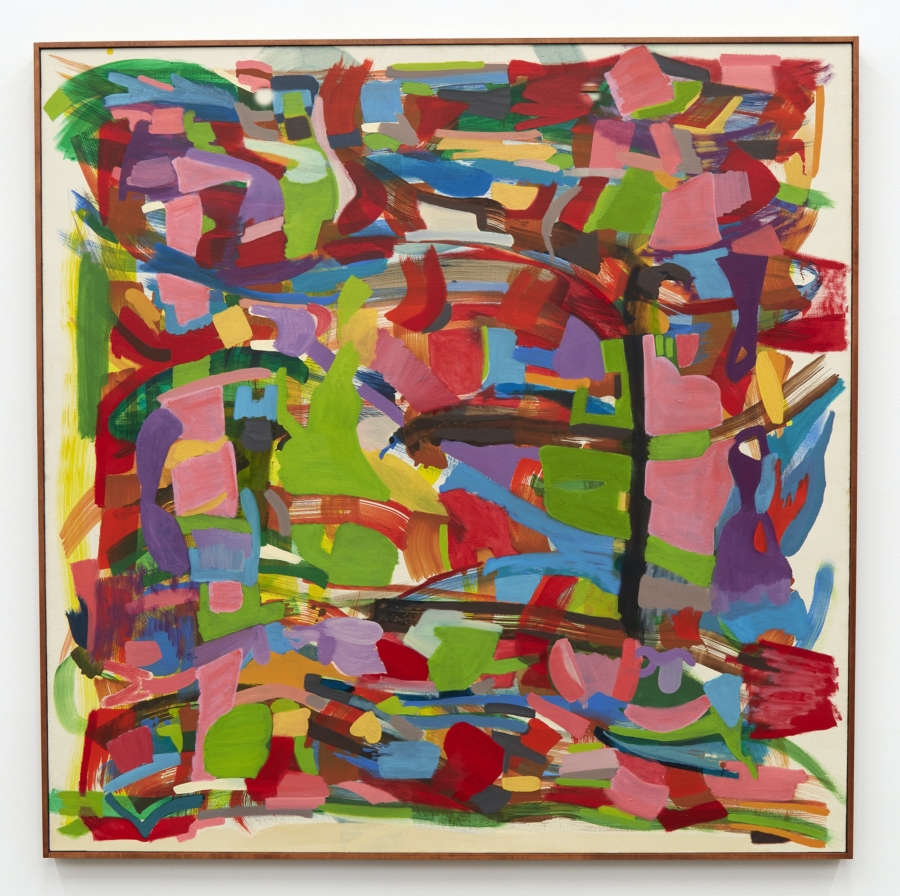July-August 2022
Download as PDF
View on The Brooklyn Rail

Marley Freeman, ones former other one, 2021. Oil and acrylic on linen, 54 1⁄8 × 54 1⁄8 inches. Courtesy Karma, New York.
Marley Freeman is breaking loose from herself. Not to worry; even as she moves forward, she, like Janus, keeps an eye on the past. In this, her second solo show with Karma (her first was in 2019), she is clearly shredding her ties to figuration, but not entirely or absolutely: several of the smaller works here contain human figures and faces reminiscent of her 2020 work. The new body of work confirms Freeman’s already-established status as a consummate colorist working in an Abstract Expressionist idiom, but one that is more European, recalling the style of COBRA, Asger Jorn, and most especially the long-forgotten Bram van Velde, whose ability to subdivide the canvas and isolate elements within painted frames finds an echo in Freeman. The distinction between Europe and the United States in this case is critical: the COBRA painters often characterized their work with biomorphic or anthropomorphic images, and it is that ability to retain or eschew figuration that defines Freeman’s artistic point of view.
Size in Freeman’s new work definitely matters. Her previous show was composed mainly of modestly-sized canvases, but the larger works in the front gallery here—roughly 54 by 54 inches—evince a confidence as well as an artistic will-to-power. She dominates the painterly space, taking possession of it. The largest work, ones former others one (2021), is a dazzling play of horizontal and vertical strokes in a mesmerizing deployment of pink, green, and blue punctuated by dramatic horizontal and vertical black striations. The overall effect is a fixed vertigo. Each isolated section of the canvas, again in the mode of Bram van Velde, whose palate, like Freeman’s is subdued rather than garish, contains its own message. At the same time, each part relates to the totality to create absolute pictorial unity, or a rhythm, as James Joyce puts it, “the first or formal relation of part to part in any whole or of any whole to its part.”
Rhythm in this sense is probably the best tool for assessing Freeman’s accomplishment in this show. Another large piece, a self area (2021), delves even more deeply into the power of color, but these masses of color dance with one another on the canvas. This visual musicality reappears in inanimate memory (2021) an almost topographic painting, almost a landscape architect’s project for turning nature into art with rivers and farmland suggested but not factually represented. The shapes and colors constitute a bird’s-eye-view of an imaginary place somewhere in the artist’s mind.
While the work in the front gallery represents Freeman’s current artistic thinking, the work in the back gallery, all of smaller dimensions, constitutes a metaphor for Freeman’s artistic memory, a place where chronology no longer matters. We’re taken back to the domesticity of 2020 in do thing in chaos (2021): a loving couple in an erotic snapshot that simultaneously commemorates them and, in the background, Freeman’s abstract preferences. More overtly Expressionist, I gentle you (2022) evokes Alexej von Jawlensky’s real or imaginary portraits which Freeman translates into her personal color spectrum. So, the figurative painter lives on these gems, but there is also an abstract energy that will simply not be repressed.
A tiny 8 by 9 inch oil and acrylic on linen, tuned to existence (2021), is one of the most powerful pieces in the entire show. First, there is the painted frame, rough brushstrokes holding the work together. Then, across the painterly space, a wild dance of green shapes. It is as if Freeman had compressed her creative energy and locked it in a box. The back gallery is also a place of restraint, where Freeman’s exuberance imposes limitations on itself. This is not repression or self-censoring, but Freeman’s acceptance of a problem endemic to so much of poetry and art: how do I translate my energy into a coherent totality? Poets can turn to the sonnet to control their self-expression; painters must impose structure on themselves by limiting their field of operation to an arbitrarily-sized canvas.
So many of these smaller works, venuses balcony (2020) and purple verbena (2021) for instance, are like visions into a bottle containing a genie: an immense power is held in, controlled, and directed by Marley Freeman.



